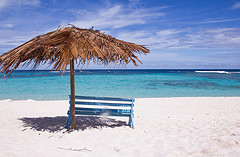Motivate...

When you think of the tropics, or the word "tropical," you might picture white, sandy beaches, and perhaps sipping on a refreshing, fruity beverage (complete with a tiny umbrella in your glass, of course). Besides being a favorite vacation destination for many people, the tropics are home to some fascinating meteorology. One of the reasons locations in the tropics are such popular vacation destinations is a seemingly endless supply of sunny days and balmy breezes, but there's much more to tropical weather than that! In fact, some areas of the tropics are known for persistent rain (like rain forests that ring the equator).
Whether sunny or rainy, the hallmark of tropical weather is persistence. Weather patterns don't change much from day to day, and a big reason for the lack of variation is that the weather in the tropics is not dictated by the same driving factors as in the mid-latitudes -- namely temperature gradients. Cold fronts, warm fronts, and mid-latitude cyclones typically aren't found in the tropics because temperature gradients tend to be small overall.
Another curious characteristic of tropical weather is that winds tend to blow from only a few directions during the course of a year. Why is that? Based on what you've learned about the wind, the persistence of a few wind directions must mean that the pressure patterns don't change very much. So, fairly constant pressure patterns are present in the tropics (aside from the occasional tropical cyclone, which we'll cover in the next lesson) along with typically small temperature gradients.
In this lesson, we'll explore what causes persistent weather in the tropics, as well as explore the seasonal variations that do occur (some areas have a well-defined "wet season" and a well-defined "dry season"). We'll also explore the general circulation of the air in the tropics, which results in some of the tallest thunderstorms on the planet, as well as the driest deserts. We'll also discuss the Indian Monsoon and El Niño -- two of the more famous weather patterns in the tropics.
The tropics are full of "weather" that needs studying. So, pull up a beach chair and let's get started!